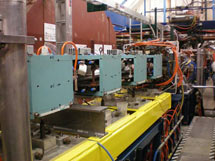
Handy Links
SLAC News Center
SLAC Today
- Subscribe
- Archives: Feb 2006-May 20, 2011
- Archives: May 23, 2011 and later
- Submit Feedback or Story Ideas
- About SLAC Today
SLAC News
Lab News
- Interactions
- Lightsources.org
- ILC NewsLine
- Int'l Science Grid This Week
- Fermilab Today
- Berkeley Lab News
- @brookhaven TODAY
- DOE Pulse
- CERN Courier
- DESY inForm
- US / LHC
SLAC Links
- Emergency
- Safety
- Policy Repository
- Site Entry Form

- Site Maps
- M & O Review
- Computing Status & Calendar
- SLAC Colloquium
- SLACspeak
- SLACspace
- SLAC Logo
- Café Menu
- Flea Market
- Web E-mail
- Marguerite Shuttle
- Discount Commuter Passes
-
Award Reporting Form
- SPIRES
- SciDoc
- Activity Groups
- Library
Stanford
Around the Bay
Clobbering Electron Clouds
Researchers at SLAC and other institutions are creating a sort of pest control for particle beams: squashing the clouds of electrons that gather in accelerators and disrupt experiments.
"Some methods are already there… we know they work," said Mauro Pivi, a SLAC scientist in the Accelerator Design Department. But in order for future colliders such as the proposed International Linear Collider, or ILC, to carry off experiments of unprecedented small beam sizes, the beams must be perfect and the pipes pristine. "Even a small electron cloud could be a problem," Pivi said.
Colliders delve for the universe's secrets by smashing together oppositely charged subatomic particles and examining the resulting debris. The particles accelerate toward their collision point as tightly focused bunches traveling through two long beam pipes. But particles emanating from the bunches often knock electrons from the walls of the beam pipe. These electrons bump into others. Soon the pipe hosts a cloud of electrons that ruins the beam's focus, or emittance. As a result, the colliding bunches lose their wallop.
SLAC scientists and their international colleagues previously used the PEP-II collider to test several ways of dissolving the pesky clouds. To continue their work after that experiment shut down two years ago, they dissembled 82 feet of experimental beam pipes and trucked them to Ithaca, NY.
They resumed their experiments at the Cornel Electron Storage Ring Test Accelerator. CesrTA is rigged to simulate a linear collider damping ring, where positively charged particles would be focused into exceptionally thin and short bunches. The work aims to improve the damping ring's performance, which could save hundreds of millions of dollars on construction.
One way of clobbering the clouds involves figuring out which beam pipe materials grasp their electrons most tightly, to prevent them being knocked free in the first place. The team has been tracking how different materials react to the beam using detectors and removable pieces of beam pipe wall the size of an apple. For each electron that hits a titanium nitride surface, about one electron jumps out. When one hits an aluminum surface, more than two electrons emerge on average, causing a much greater problem.
"CesrTA has aluminum everywhere, everywhere," Pivi said. "It's the perfect place to test for the electron cloud." When the CesrTA ring was built in 1979, designers did not know about the electron-shedding problem and used aluminum because it was cheap and easy to handle.
The team has also been testing what happens when pipe walls are marked with deep grooves. Most escaping electrons become trapped inside the grooves where they can't pester the beam. Covered with a coating of titanium nitride or another material, these grooves are quite good at keeping the clouds away. The work is part of a worldwide, multi-institutional effort to test methods of maintaining fine weather inside beam pipes.
The clouds are expected to be at their worst when a magnetic field is present. So the team did some electron cloud gazing while bending the beam into a "Z" using a series of magnets. These preliminary experiments and projections show that slight adjustments in the strength of the field can shrink the clouds, so that other techniques can then clear them further.
Next, the team will put all of the "pest control" methods to ever more stringent tests, and continue trying the various techniques in combination. The researchers applied last December for National Science Foundation and Department of Energy funding to continue work through 2013. They expect an answer soon.
—Olga Kuchment
SLAC Today, March 25, 2010
